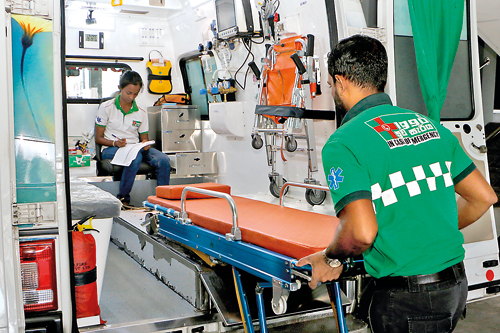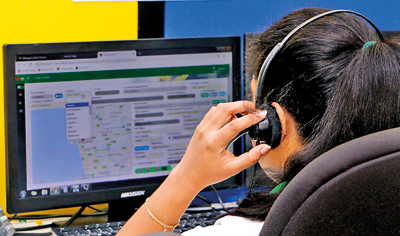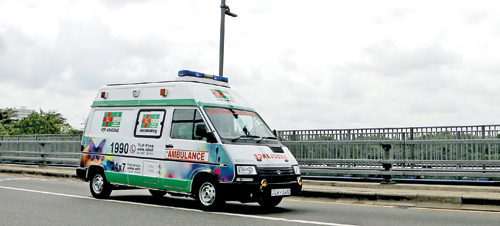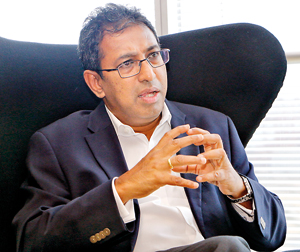1990: Just a call away
Halfway into a watte in remote Horowpothana that they realized that right in front of them in the darkness, blending in was a wild elephant, while climbing up a steep incline on foot in Deniyaya, having parked the vehicle way below, they met a couple rushing down and within seconds helped the heavily pregnant mother.
We, however, are not anywhere else but right here at Rajagiriya, looking on in amazement as calls keep coming in.

The well-equipped ambulance. Pix by Priyanka Samaraweera
This is a glimpse into the day, nay every second, in the life of the digitally-driven 1990 Ambulance Service or Suwa Seriya at the beck and call of ill or injured men, women and children in every nook and cranny of Sri Lanka, poor or rich, humble or powerful.
White and green are the ambulances and it is with blue sirens flashing that they are serving the people free of charge and have been doing so in the past three years. This is the ‘Blue Light Service’.
Launched on a small scale in Hambantota in the Southern Province on July 28, 2016, now the 1990 Ambulance Service covers the entire country – 297 state-of-the art ambulances, with an average response time of just 11.4 minutes.
On Tuesday, we see the ‘heart’ of this service – the Emergency Command & Control Centre (ECCC) where the 25 seats, to be expanded to 40, are occupied mainly by women deftly answering calls and dispatching ambulances from different locations to the emergency spot. They are supported by a 119 emergency service Police Officer with direct access to the Police Control Centre and an Emergency Response Centre Physician who has been provided by the Sri Lanka Society of Critical Care and Emergency Medicine.
Each day the 1990 Ambulance Service provides succour to more than 780 cases, fielding more than 2,800 calls per day, answering 98.9% of those calls on the first ring.
“The only office we have is this headquarters at Rajagiriya,” smiles the Chief Executive Officer (CEO) of the 1990 Suwa Seriya Foundation, Sohan de Silva, walking us through the successful ‘Journey of 1990’.
Reiterating that he is “not doing this alone”, he is justifiably proud that the team works with Formula 1 operation efficiency. It is a digitally-run operation which also uses GPS data.
The Foundation’s Directors who are the strategists are Chairperson Dumindra Ratnayake and Vijaya Malalasekera, Sandya Salgado, Prof. Asita de Silva, Dr. Sunil de Alwis, Senior Superintendent of Police (SSP) Indika Hapugoda and Namal Ranatunga who represents the Finance Ministry.

Responders to urgent calls at the ECCC
The movers and shakers at ground level are the 683 ‘pilots’ who are not just ambulance drivers but are also trained to assist the 698 Emergency Medical Technologists (EMTs). The pilot and the EMT are the pair in the ambulance. The others include 54 Emergency Response Officers (EROs); 19 Emergency Management Executives (EMEs); and 39 administration staff, all making a total of 1,488, to be increased to 1,998 shortly.
In the past three years, Suwa Seriya has answered 1.2 million calls, marking 250,000 as ‘emergencies’, facilitating 220,000 hospitalizations, providing as many as 3,640 emergencies with first-aid, while helping to deliver 97 babies within the ambulances.
Many have been the “on-the-job” lessons, the service has learnt as they responded to five ‘major mass casualty incidents’ including the Wellawatte building collapse, Grandpass fire and floods elsewhere and also the first ‘multi-site mass casualty incident’ on Easter Sunday, April 21.
“Twenty-five of our ambulances were at the bomb blast sites,” explains Mr. de Silva, reliving those tense moments when the ambulances arrived at the St. Sebastian’s Church in Katuwapitiya in five minutes and left with the injured in three minutes.
Suwa Seriya’s records show that 34% of its overall cases were illnesses linked to non-communicable diseases (NCDs) including losing consciousness, cardiac/cardiovascular, respiratory trouble and strokes/cerebrovascular events and 17% road traffic accidents.
 The CEO is quick to point out that “nothing has been left to chance”. The ‘placement’ of the ambulances across the country has been on calculations: one ambulance for every 50,000-60,000 population and a maximum radius of 25-35 kilometres and in difficult terrain 15kms. They are strategically-kept at police stations as the latter would get information on accidents and assaults promptly.
The CEO is quick to point out that “nothing has been left to chance”. The ‘placement’ of the ambulances across the country has been on calculations: one ambulance for every 50,000-60,000 population and a maximum radius of 25-35 kilometres and in difficult terrain 15kms. They are strategically-kept at police stations as the latter would get information on accidents and assaults promptly.
All EMTs receive initial training at the Gandhi Memorial Hospital and the GVK EMRI (Emergency Management and Research Institute) in India. GVK is a non-profit organization based on the Public Private Partnership model founded by Dr. Gunupati Venkata Krishna (GVK) Reddy of India.
The pilots are trained in first-aid, tactical driving skills and more in Sri Lanka.
Next we get a peek into an ambulance. The fleet has two types of ambulances – standard and four-wheel drive which are equipped with four types of stretchers and accident and emergency equipment as well as extrication tools which come in handy in accidents.
Mr. de Silva is appreciative of the support of the 119 police officer based at the ECCC and also as of August 1, the two physicians there from whom the EMTs take instructions.
The ambulances take the patients not to the closest state hospital but to the state hospital that is the best in dealing with the patient’s illness. Using Google Traffic, it may also not be the nearest ambulance but the fastest one, considering traffic, that will respond to the emergency.
While if there is a specific patient request, he/she will be taken to a private hospital, as 1990 is a pre-hospital care delivery ambulance service, they do not move patients between hospitals (intra-hospital transfers).
At the ECCC, we see the ‘talk’ in ‘action’. Every second, many phones light up…….a call from Gampaha with chest pain and from Ampara about an accident.
Among the challenges the service is facing, however, are the 2,000-odd (40%) prank calls streaming in.
Looking to the future, the 1990 Ambulance Service is set on introducing Android and Apple apps.
Mr. de Silva adds: “All the money, Rs. 2 billion a year, being channelled to this public service belongs to the public. There are checks and balances. If these protocols are broken people will die and every second matters and the service staff knows it.”
| A promise fulfilled | |
How did it all begin? Flashback to 2013. A group of friends returning after a holiday in four cars gathered in a knot on the road at Kuchchaveli. A rainy morn, they had seen one car hydroplaning and were looking in shock at a “lump on the road” – it was one of their friends.  Dr. Harsha de Silva Making a makeshift ambulance of one car, on the advice of a doctor among them, they are able to bring their critically-injured friend to a private hospital in Colombo, where she undergoes major spinal surgery and “thankfully” recovers fully. That was the day Minister of Economic Reforms and Public Distribution Dr. Harsha de Silva, who was then in the opposition, made a promise to himself. If he held office, he would develop a pre-hospital care ambulance service, a dire public need. Dr. de Silva did come into office and was in the right place at the right time when Indian Prime Minister Narendra Modi came a-visiting to Sri Lanka in March 2015. “The Foreign Office in India was keen to do a development project for Sri Lanka as a gesture of goodwill, linked to Mr. Modi’s visit and had a list of about 20-30. I was working in our PM’s office and told Mr. Ranil Wickremesinghe that I had a different idea to which he told me I could go ahead if I could convince Mr. Modi,” he says. Meeting Mr. Modi in the lobby of Parliament, to his suggestion, Mr. Modi had replied: “Young man, of course, let’s do it.” Smiling that he is not a young man, Dr. de Silva says that he had done his background work and knew that Mr. Modi had supported the ‘108 ambulance service’ in Gujarat when he was Chief Minister there. Mr. Modi suggested that he start small with a grant of $7.5 million, working in tandem with India’s GVK EMRI. Dr. de Silva sought the support of tech-savvy Dumindra Ratnayake who is the ‘back office’ of this initiative, while he is the ‘front-office’. The service started with 88 ambulances and as the one-year operation was drawing to a close, Dr. de Silva was Deputy Minister of Foreign Affairs, meeting Mr. Modi twice in his new role. The ambulance service was flourishing and when he requested expansion, Mr. Modi had only one condition – “If the Government of Sri Lanka takes charge, I’ll help.” Dr. de Silva with the support of Prime Minister Wickremesinghe was able to see it through, with India providing the balance ambulances to make it a total of 297 along with another grant of $15.2m. Among those he lauds for making the service a reality are former Indian Foreign Secretary S. Jaishankar and Indian High Commissioners to Sri Lanka Yashvardhan Kumar Sinha and Taranjit Singh Sandhu and in Sri Lanka Arjuna Obeysekera who was then in the Attorney General’s Department (with whom he sat and wrote from scratch the 1990 Suwa Seriya Act which no one opposed, be it government or opposition) and the service’s Chief Medical Officer Dr. Srilal de Silva. Pointing out that this is the second largest grant (first was the tsunami housing grant) given by India ever to Sri Lanka, he says that it was the best people-to-people gift. “Experts, data-driven technocrats, run Suwa Seriya with no political interference. This is the best deliverable of the government, the best public service, run like a private enterprise with accountability and no allegations of corruption,” he says, sending out a message to the public. “Call 1990 – we will save your life!”
|


